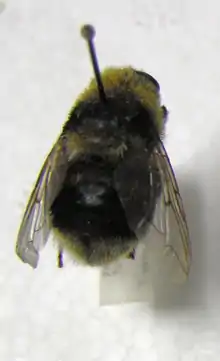Cephenemyia ulrichii
Cephenemyia ulrichii or the moose botfly, also called the elk botfly, moose nose botfly or moose throat botfly, is a large botfly that resembles a bumblebee. In the wild, they attack chiefly the nostrils and pharyngeal cavity of moose (also known as elk in Europe), but have been found in other deer species. There have also been several cases of C. ulrichii squirting their larvae into the eyes of human beings, a somewhat painful event that requires medical attention to forestall any possibility of serious damage.
| Cephenemyia ulrichii | |
|---|---|
 | |
| Scientific classification | |
| Kingdom: | |
| Phylum: | |
| Class: | |
| Order: | |
| Superfamily: | |
| Family: | |
| Subfamily: | |
| Tribe: | |
| Genus: | |
| Species: | C. ulrichii |
| Binomial name | |
| Cephenemyia ulrichii Brauer, 1863 | |
Description
The adult C. ulrichii botfly is 16–18 mm long, its body covered with fluffy hairs of yellow, black and white, making it look like a bumblebee. Mouth parts are reduced and, like other adult Cephenemyia, they cannot feed.[1]
Eggs hatch inside the female into first instar larvae, which are minute, white with black heads and barbed. In sunny weather, from July to September, females seek out an appropriate host site, typically the nostrils of a moose, and forcefully eject larvae onto its surface. Larvae enter their second instar in the moose's nostrils, then travel to its throat for the third instar.[1] Third instar larvae have rows of spines on both ventral and dorsal surfaces and may be up to 4 cm long.[2]
When fully formed, the larva is ejected by the moose, mixed with blood and mucus. It pupates in the soil.[1]
Habitat
C. ulrichii are common parasites of moose in northeastern parts of Scandinavia, but have recently expanded their range into southern Sweden.[1] They have also been reported in Denmark, northeast Norway and the Baltic states.[2][3]
Although once thought to be a species specific to Alces alces, they have recently been found in western roe deer (Capreolus capreolus) near Helsinki.[2]
Economic and medical impact
Several cases of human ophthalmomyiasis due to C. ulrichii have been reported in Sweden and Finland.[4] In one case in 2010, a woman was walking in the woods near Falun in Dalarna, Sweden, when a moose botfly squirted more than 30 larvae into her eye. The larvae were removed by a doctor before they attached to the cornea, which can cause serious damage.[4] Due to their barbs, it is difficult to wash the larvae out of the eye.[5] One physician has suggested that C. ulrichii mistakes a human eye for the nostril of a moose because human eyes face forward, as do moose nostrils.[5]
Botfly larvae of other kinds have also been known to cause eye problems for human beings.[6]
References
- Jaenson, Thomas G.T. (2011). "Larver av nässtyngfluga i ögat - ovanligt men allvarligt problem. Fall av human oftalmomyiasis från Dalarna och sydöstra Finland redovisas (summary)". Lakartidningen. 108 (16). Archived from the original on 27 September 2011. Retrieved 21 June 2011.
Moose bot fly larvae are common parasites of moose (Alces alces) in north and central Sweden. Last year, however, C. ulrichii was on three occasions recorded for the first time from Småland, south Sweden.
- Nilssen, Arne C.; Marja Isomursu; Antti Oksanen (2008). "The moose throat bot fly Cephenemyia ulrichii larvae (Diptera: Oestridae) found developing in roe deer (Capreolus capreolus) for the first time". Acta Veterinaria Scandinavica. 50: 14. doi:10.1186/1751-0147-50-14. PMC 2440746. PMID 18518973. Retrieved 22 June 2011.
- Jaenson, Thomas G.T. (2011). "Larver av nässtyngfluga i ögat - ovanligt men allvarligt problem. Fall av human oftalmomyiasis från Dalarna och sydöstra Finland redovisas". Lakartidningen (in Swedish). 108 (16): 928–30. Archived from the original on 27 September 2011. Retrieved 21 June 2011.
- Nilssen, Arne C.; Haugerud, Rolf E. (1994). "The moose nose bot fly Cephenemyia ulrichii Brauer (Diptera: Oestridae) reported in Norway for the first time". Rangifer. 14 (2): 16–17. doi:10.7557/2.14.2.1139. Retrieved 22 June 2011.
- Spuņģis, Voldemārs; Karpa, Aina (2008). "Cephenemyia ulrichii (Diptera: Oestridae) in Latvia" (PDF). Latvijas entomologs. 45: 14. Retrieved 22 June 2011.
- "Swedish insect shoots larvae into victims' eyes". TheLocal.se. 4 May 2011. Retrieved 21 June 2011.
- Jaenson, Thomas G.T. (2011). "Larver av nässtyngfluga i ögat - ovanligt men allvarligt problem. Fall av human oftalmomyiasis från Dalarna och sydöstra Finland redovisas". Lakartidningen (in Swedish). 108 (16): 928–30. Archived from the original on 27 September 2011. Retrieved 21 June 2011.
När flughonan misstolkar en människa som ett lämpligt värddjur, feltolkar hon troligen även människans ögon, som är framåtriktade, som värddjurets näsborrar. De »normala« värddjurens näsborrar är ju framåtriktade, liksom människans ögon. Människans näsborrar är däremot nedåtriktade och är därför knappast synliga för flughonan.
- "When the female botfly mistakes a human for a suitable host animal, she is probably in fact mistaking the human eye, which is forward-facing, for the host animal's nostrils. The "normal" host animals' nostrils are forward-facing, like the human eye. The nostrils of a human, however, are downward-facing and are therefore hardly visible to the botfly." - Lagacé-Wiens, Philippe (2008). "Human Ophthalmomyiasis Interna Caused by Hypoderma tarandi, Northern Canada". Emerging Infectious Diseases. 14 (1): 64–66. doi:10.3201/eid1401.070163. PMC 2600172. PMID 18258079. Retrieved 22 June 2011.
Human myiasis caused by bot flies of nonhuman animals is rare but may be increasing.
External links
- Cephenemyia ulrichii at Fauna Europaea